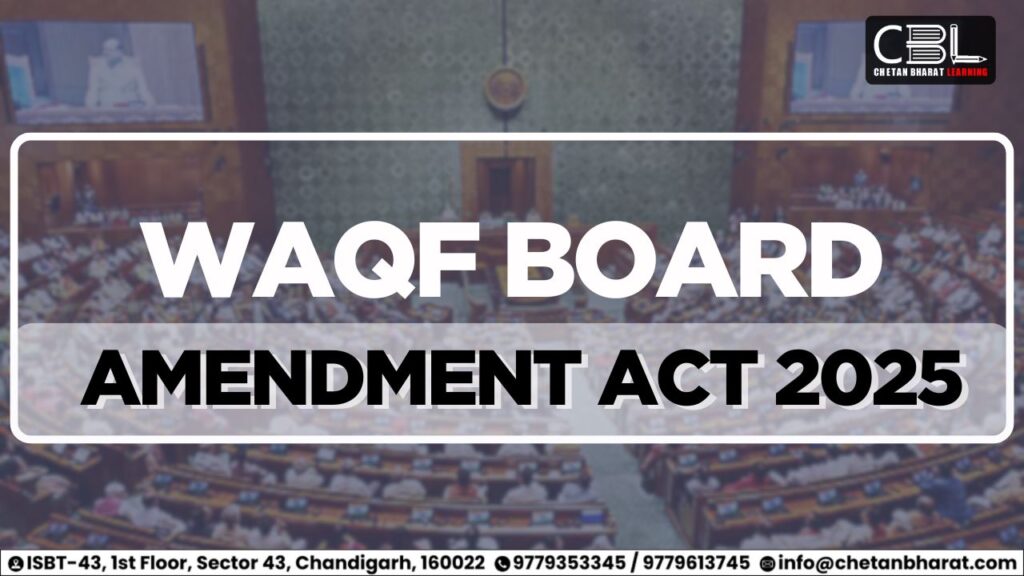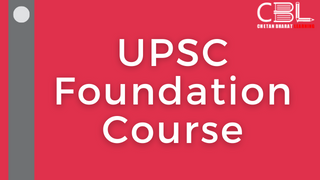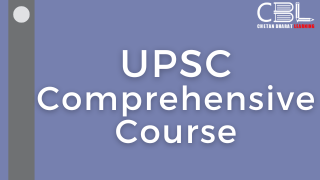
Important for UPSC, State PCS
Prelims: Lok Sabha Passes Waqf (Amendment) Bill , Waqf Amendment Act .
Mains: General Studies Paper-2 : The Waqf (Amendment) Act, 2025 ,
The Waqf (Amendment) Act, 2025
Introduction:
The Waqf (Amendment) Act, 2025, has been passed by the Parliament and received Presidential assent. This legislation amends the Waqf Act, 1995, granting the government increased powers to regulate Waqf properties and resolve related disputes. The amendments aim to enhance the efficiency of Waqf Boards, modernize definitions, improve the registration process, and introduce technology-driven record management.
What is Waqf ?
Waqf refers to a permanent charitable or religious endowment made by a Muslim. Such properties may be dedicated for building mosques, schools, hospitals, or other public institutions. Waqf is inalienable, meaning it cannot be sold, gifted, inherited, or encumbered.
There are 8.72 lakh Waqf properties in India, covering over 38 lakh acres of land.

What is the Waqf Board and the Waqf Act, 1995 ?
The Waqf Act, 1995 was enacted to manage Waqf properties and to establish State Waqf Boards for administration, regulation, and resolution of Waqf-related matters.
Waqf Boards are statutory bodies responsible for the management, preservation, and development of Waqf properties.
Evolution of Waqf Law in India
Historical legal frameworks governing Waqf have evolved through colonial and post-independence periods.
The 1995 Act was a significant reform but faced challenges in enforcement, transparency, and legal accountability, prompting the 2025 amendment.

Key Provisions of the Waqf (Amendment) Act, 2025
Separation of Trusts from Waqf:
Muslim-created trusts under other laws are no longer considered Waqf.
Individuals retain full control over such trusts.
Eligibility for Waqf Dedication:
Only practicing Muslims (minimum of 5 years) can dedicate property as Waqf.
Protection of Existing Registrations:
Properties already registered with Waqf Boards remain so unless they are disputed or identified as government land.
Women’s Rights in Family Waqf:
Women must receive their rightful inheritance before Waqf dedication.
Special provisions for widows, divorced women, and orphans.
Removal of Section 40:
Eliminates the Waqf Board’s authority to unilaterally declare any property as Waqf.
Waqf Tribunals:
Comprises a District Judge, a Joint Secretary-level government officer, and an expert in Muslim law.
Tribunal decisions can be appealed to the concerned High Court within 90 days.
Dispute Resolution for Government Lands:
Senior officers (above Collector rank) will investigate Waqf claims on government land to prevent misuse.
Reduced Annual Contributions:
Waqf institutions’ contributions to the Board reduced from 7% to 5%.
Annual Audit Reforms:
Institutions earning over ₹1 lakh must be audited by State-appointed auditors.
Technology and Central Portal:
A centralized online portal for Waqf property management.
Mutawallis (caretakers) are required to register property details on the portal.
Inclusive Representation in Waqf Boards:
Two non-Muslim members to be included for inclusivity.
At least two Muslim women must be appointed.
Representation from Shia, Sunni, Bohra, Aghakhani, and OBC Muslim communities is mandatory.
Application of the Limitation Act, 1963:
Sets time limits for filing Waqf-related legal claims to avoid prolonged litigation.
Why Was the Amendment Needed?
Irrevocability of Waqf Properties:
The principle “once a Waqf, always a Waqf” created complex ownership disputes.
Example: Controversies such as the Bet Dwarka island ownership dispute.
Poor Management and Encroachments:
Inefficiency and widespread misuse of Waqf lands.
Example: Karnataka saw the notification of 40 Waqf properties (1975–2020), including graveyards, lakes, temples, and public lands.
Lack of Judicial Oversight:
The 1995 Act barred appeals against Tribunal decisions, limiting transparency and legal recourse.
Misuse of Section 40 Powers:
Arbitrary declaration of private properties as Waqf.
Example: In Kerala, protests erupted among 600 Christian families over claims on ancestral lands.
Concerns Associated with the Amendment
Increased Government Control:
Government can now regulate and determine the status of Waqf properties, reducing Waqf Board autonomy.
Dilution of Muslim Representation:
Inclusion of non-Muslims in Waqf Boards seen as interference in religious management (Article 26).
Unclear Definition of “Practising Muslim”:
No legal clarity, which may lead to inconsistent interpretations and legal disputes.
Abolition of “Waqf by User” Principle:
May result in long-standing religious sites losing their Waqf status.
Conclusion
The Waqf (Amendment) Act, 2025 introduces significant legal and technological reforms to improve transparency, governance, and dispute resolution in the Waqf system. However, several concerns—particularly about government control, representation, and religious autonomy—remain contentious. These must be addressed through inclusive dialogue and well-defined rules, which are yet to be released.
The coming implementation guidelines are expected to clarify ambiguities and resolve key concerns surrounding the amendment.
CBL Practice Questions for Prelims
Which of the following provisions are included in the Waqf (Amendment) Act, 2025 ?
- Introduction of centralized digital portal for Waqf property management
- Deletion of the “Waqf by User” principle
- Inclusion of non-Muslim members in Waqf Boards
- Allowing appeal to High Court against Waqf Tribunal orders
Select the correct answer using the code below:
A. 1 and 2 only
B. 1, 2 and 3 only
C. 1, 3 and 4 only
D. 1, 2, 3 and 4
Answer: D
Explanation: All four are provisions under the amended act.
CBL Mains Practice Question
Section 40 of the Waqf Act, 1995 granted sweeping powers to the Waqf Boards, often leading to misuse. Evaluate how its removal under the 2025 Amendment Act addresses this issue and what challenges may still persist.




Leave a Reply
You must be logged in to post a comment.